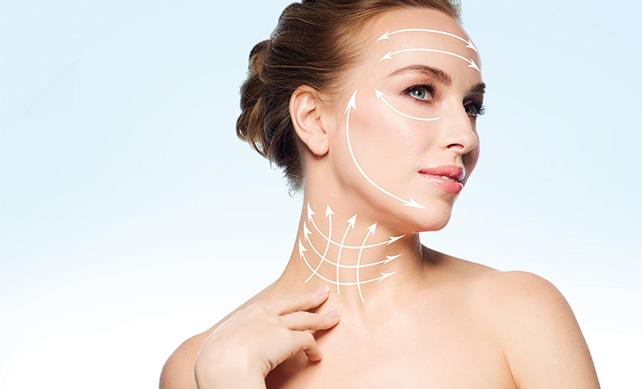WHAT IS A FACELIFT PROCEDURE?
A facelift, also referred to as a rhytidectomy, is a cosmetic surgical procedure designed to enhance the youthful appearance of the face and neck. It involves the removal of excess facial skin, tightening of underlying muscles, and repositioning of the skin to create a smoother, more rejuvenated look.
The process can aid in diminishing the visibility of wrinkles, drooping skin, jowls, and other indications of aging. A facelift can be conducted employing diverse methods, tailored to the patient’s objectives and the surgeon’s inclinations. These methods encompass the classic facelift, limited incision facelift, and neck lift.
The duration of recovery may differ based on the complexity of the procedure. Typically, individuals can anticipate swelling, bruising, and discomfort in facial muscles for several weeks following surgery. It’s crucial to communicate with a certified plastic surgeon about potential risks and complications before deciding on a facelift.



What Are The Facelift Techniques
Various facelift techniques are conducted using general anesthesia, each offering distinct advantages and limitations. Plastic surgeons typically choose the most suitable technique based on the patient’s objectives, facial structure, and skin condition. Common facelift methods comprise:
Here are various techniques for facelift procedures:
- Traditional Facelift: Also known as a “full facelift,” this method involves creating incisions along the hairline at the temples, around the ears, and ending at the lower scalp. The surgeon then lifts the skin, tightens underlying muscles, and removes excess and loose skin. It effectively addresses significant sagging and aging in the face and neck.
- Limited Incision Facelift: Also called a “mini facelift” or “short scar facelift,” this technique utilizes smaller incisions, typically around the ears and sometimes within the temple’s hairline. It’s suitable for patients with moderate sagging and aging concerns, offering a quicker recovery time and reduced scarring compared to a traditional facelift.
- Neck Lift: A neck lift, or “platysmaplasty,” targets the neck and jawline, addressing issues such as sagging skin, “turkey neck,” and jowls. Incisions are made around the earlobe, front of the ear, and behind the ear, extending into the lower scalp. It’s often combined with a traditional or limited incision facelift for comprehensive facial rejuvenation.
- Mid-Face Lift: This technique focuses on the mid-face area, including the cheeks and lower eyelids. Incisions are typically made within the hairline, corner of the mouth, or inside the mouth. The surgeon lifts and repositions fat and soft tissues to restore volume to the cheeks and minimize nasolabial folds.
- SMAS Facelift: This technique targets the Superficial Musculo-Aponeurotic System (SMAS), addressing the underlying muscular layer of the face that contributes to sagging and wrinkles. Incisions are similar to those used in a traditional facelift. The surgeon tightens the SMAS layer and repositions the skin.
- Deep Plane Facelift: This method goes beyond the SMAS facelift by addressing deeper layers of facial tissue, including fat and connective tissue. Working at a deeper level can provide more natural and long-lasting results, although it may involve a longer recovery time and a higher risk of complications.
These are just a few examples of facelift techniques. A qualified plastic surgeon may combine these approaches or tailor the procedure to meet the patient’s specific goals and facial characteristics. It’s crucial to consult with a board-certified plastic surgeon to determine the most suitable technique for individual needs.
Candidates For Facelift
Potential candidates for a facelift typically seek to improve visible signs of aging in their face and neck. The ideal candidates for this procedure usually exhibit the following characteristics:
- Good overall health: Candidates should be in good physical health, without any medical conditions that could pose risks during surgery or impede the healing process. A thorough medical evaluation is typically conducted to ensure safety.
- Non-smoker: Smoking can significantly heighten the risk of complications and hinder healing. Surgeons often advise patients to cease smoking several weeks before and after the procedure to minimize these risks.
- Realistic expectations: Candidates must have a clear understanding of what a facelift can achieve and maintain realistic expectations about the results. While a facelift can provide substantial rejuvenation, it cannot halt the aging process or completely alter one’s appearance.
- Skin elasticity: Facelift candidates should possess a certain level of skin elasticity, which aids in the skin’s ability to adjust to its new contours and achieve a smooth, natural appearance.
- Visible signs of aging: Ideal candidates are those who display noticeable signs of aging such as sagging skin, wrinkles, jowls, or loss of facial volume. A facelift can effectively address these concerns, resulting in a more youthful and revitalized appearance.
- Emotional stability: Undergoing cosmetic surgery can be emotionally challenging. Candidates should be emotionally stable and prepared to manage the physical and psychological aspects of the procedure and recovery.
Consulting with a board-certified plastic surgeon is essential to determine suitability for a facelift. The surgeon will assess the candidate’s medical history, discuss their goals, and recommend the most appropriate approach based on their individual needs and circumstances.






